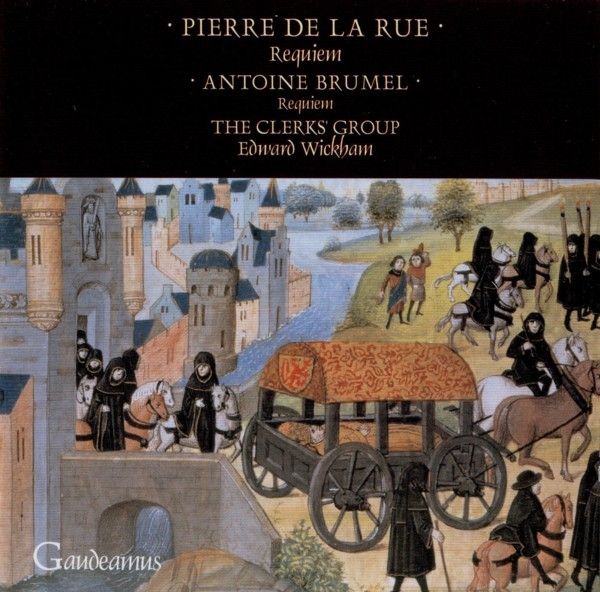Requiem. Pierre DE LA RUE · Antoine BRUMEL
The Clerks' Group

medieval.org
Gaudeamus CD GAU 352
2005
Pierre de LA RUE
(c. 1460-1518)
Requiem
01 - I. Introit.Requiem aetermam [4:22]
02 - II. Kyrie eleison [3:58]
03 - III. Psalm. Sicut cervus [3:20]
04 - IV. Offertory. Domine Jesu Christe [5:20]
05 - V. Sanctus & Benedictus [4:06]
06 - VI. Agnus Dei [3:52]
07 - VII. Communion. Luceat eis Domine [2:34]
Antoine BRUMEL
(c. 1460-1520)
Requiem
08 - I. Introit. Requiem aeternam [5:24]
09 - II. Kyrie eleison [3:27]
10 - III. Sequence. Dies irae [13:10]
11 - IV. Sanctus & Benedictus [1:44]
12 - V. Agnus Dei [1:40]
13 - VI. Communion. Luceat eis Domine [3:18]
(world premiere recording, salvo #10)
THE CLERKS' GROUP
Edward Wickham
Lucy Ballard, William Missin - altos
Chris Watson, Matthew Vine - tenors
Edward Wickham, Robert Macdonald, Andrew Westwood - basses
Produced by David Trendell
Engineered by David Wright
Edited by David Wright
Recorded at St Andrew's, West Wratting, 2nd, 3rd and 4th February 2004
Designed by Studio B, The Creative People
Cover: How Alexander the Great (356-323 BC) Passed Away and Was Buried,
from the manuscript by Jean Vauquelin (vellum) by French School, (15th century),
Musee de la Ville de Paris, Musee du Petit-Palais, France,
Lauros / Giraudon, Bridgeman Art Library

The chatter of chaplains reciting Requiems in scattered chantries
must have been a familiar sound in the Medieval Cathedral. This was not
a liturgy restricted to funeral services. One of the most common
strategies for evading - or a least expediting - the soul's sojourn in
Purgatory was to leave financial provision for the intoning of Requiem
masses on the death day of the sinner in question; and just in case the
Almighty was not paying attention the first time, bequests would often
specify several recitations, one after the other.
The Office of the Dead - drawing its more familiar title, the Requiem, from
the opening word of the liturgy - was therefore commonplace in the late
Medieval Church. Yet only in monastic institutions would the masses
been routinely sung, and then in chant. Examples of polyphonic Requiem
cycles are few and far between in the 15th century, possibly because
when leaving behind musical memorials, those wealthy priests and
musicians most likely to endow polyphony opted for alternative
expressions of votive piety. Machaut, for example, composed for the
benefit of his soul a Mass of Our Lady rather than a Requiem cycle.
Though the second half of the 15th century saw the Mass Ordinary cycle
(consisting of Kyrie, Gloria, Credo, Sanctus and Agnus Dei movements)
assume a position as the most complex, compositionally ambitious and
substantial genre in Western art music, the polyphonic Requiem cycle
does not seem to have attracted the same interest, nor stirred the
imagination of the ever-competitive composers of the Early Renaissance.
The two earliest settings are by Ockeghem and Dufay, the former
surviving incomplete in a source from the late 15th century but
probably penned in the 1460s, and the latter now lost completely
Perhaps there was simply little call for elaborate polyphonic
Requiems: the corollary of this being that those which were composed
must have been for special occasions. Sadly, historical information is
too sparse for us to be able to match the earliest polyphonic Requiems
to particular events even in the case of Pierre de la Rue whose
biography is relatively well-documented. Based for a large part of his
career at the court of Margaret of Austria - regent in the Netherlands
on behalf of Charles V - La Rue's music enjoyed wide circulation in
manuscripts emanating from Margaret's court, and the Missa Pro fidelibus defunctis (to give it its full title) appears in four different sources.
Not altogether surprising for such an eye and earcatching work. La
Rue's Requiem as notated employs extraordinarily low ranges for the
bass voices. To singers familiar with the usual layout and clefs of a
Renaissance manuscript, the visual impact alone must have been
powerful. Whether this visual symbol of solemnity should be literally
interpreted as indicating actual low-sounding pitches is a question of
some debate. Renaissance notation was not intended to indicate fixed
sounding pitches, and one can imagine a flexible, practical approach to
transposition being taken by performing ensembles, based on the
abilities of the singers involved. Transposition of La Rue's Requiem
upwards to avoid the subterranean ranges is possible, though not always
comfortable. However, the model for this mass provides some context for
the eccentric scoring and invites us to consider the work as part of a
tradition of low-voice composition.
La Rue's main influence
here is the Requiem of Ockeghem. La Rue's choice of movements to set
polyphonically (including the Graduale which in this period was the
psalm "Sicut cervus") and his manipulation of scoring for dramatic
contrast (the additional voice for the final Kyrie, for example, or the
duets at the opening of the Graduale) are surely the direct result of
familiarity with and admiration for Ockeghem's cycle. La Rue's use of
low ranges is another facet of this influence, for while Ockeghem never
notated anything quite this low in his Requiem, he does relish the
sound of low ensemble singing and in other works (Missa Fors seulement and Intemerata Dei mater) notates similar ranges for the basses as La Rue does here.
La Rue's mass is therefore a patchwork of duos, quartets and
quintets, linked by a common thread of chant. The traditional Gregorian
chant of the Office of the Dead is never far away, presented most often
- in an adorned fashion - in the upper voice of whatever combination of
voices is singing at the time. All the earliest polyphonic Requiems
maintain an intimate relationship with these chants, such that the
balance between free expression and functionality which in Mass
Ordinary cycles of the period so often tips towards the former, in some
Requiems favours the latter. The mass by Brumel is a case in point.
Some of the music here aspires to not much more than elegant
harmonisation of the chant tunes. That the results are so beguiling is
a testament to the languid, easy charm of Brumel's style, one which
gently manipulates mode and generates long, poised melodies out of the
simplest of ideas.
The way in which chant is reinvented by Brumel as polyphonic melody can be heard most easily in the Dies irae,
as it happens also the first polyphonic setting of this text. This
lengthy poem - which represents the emotional epicentre of so many
later Requiem settings - had a semi-detached relationship with the
Office of the Dead until after the mid 16th-century reform of Roman
Catholic liturgy at the Council of Trent. Its appearance in Brumel's
mass suggests an unusual liturgical environment, while its treatment -
alternating chant and polyphony, the latter repeating in the same way
as the original chant sequence - maintains a formality of approach
common to the entire cycle.
But the apparent coolness and
objectivity of Brumel's setting - in contrast to that of La Rue - is
not simply a matter of functionality. Brumel's polyphony - specifically
his use of imitation - is more controlled and consistent than La Rue's.
Quite apart from the dark sonorities of the La Rue, the internal logic
of its melodies and the way they relate is less predictable - at least
for the modern listener - than Brumel's. In Josquin's Nymphes des bois,
which sets a poem by Molinet lamenting the death of Ockeghem and which
employs the Requiem chant as a cantus firmus, Brumel and La Rue are
both mentioned by name as mourning the loss of their "bon père". The
musical heredity of the Early Renaissance is devilishly difficult to
unravel, but the compositional DNA of these two Requiems point to
Brumel's affinity with Josquin and Italian music, but to La Rue as the
more faithful son.
© Edward Wickham, 2005



